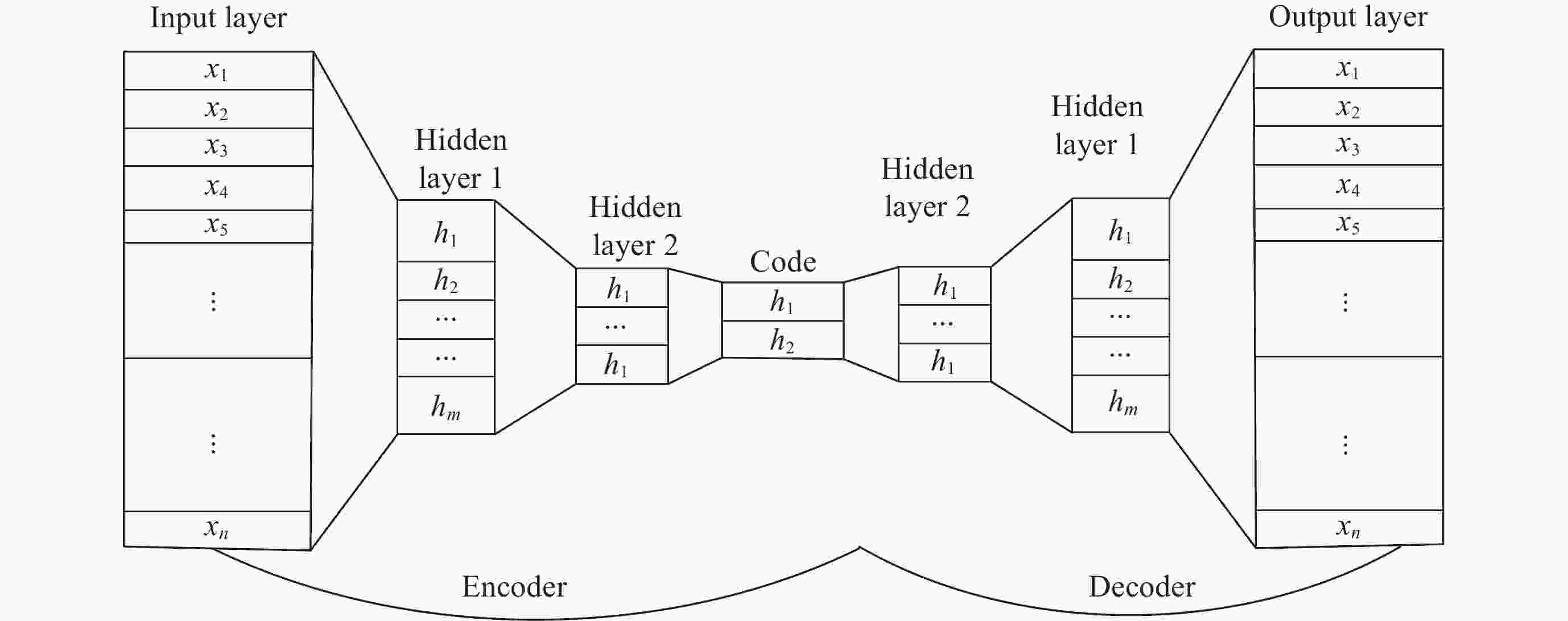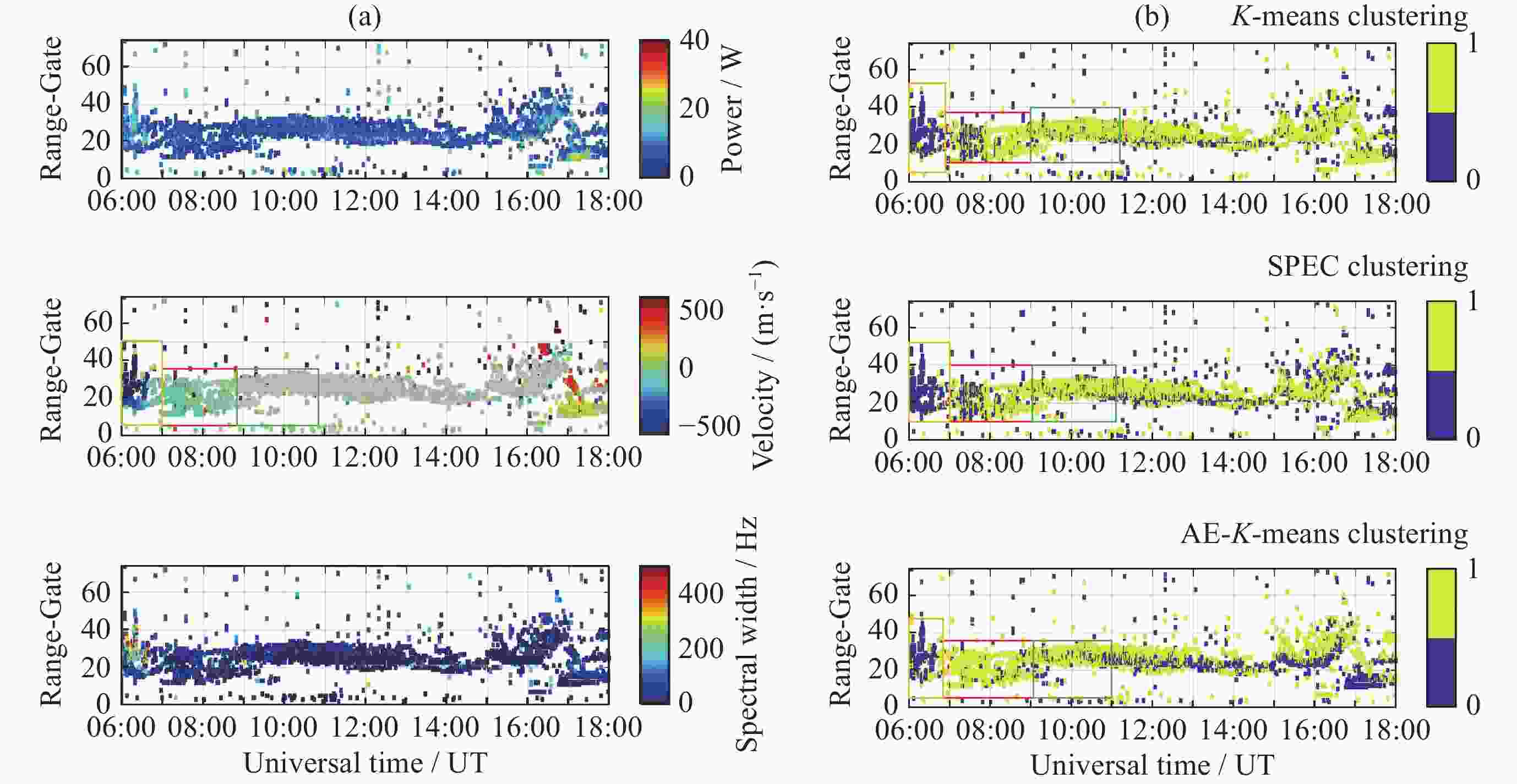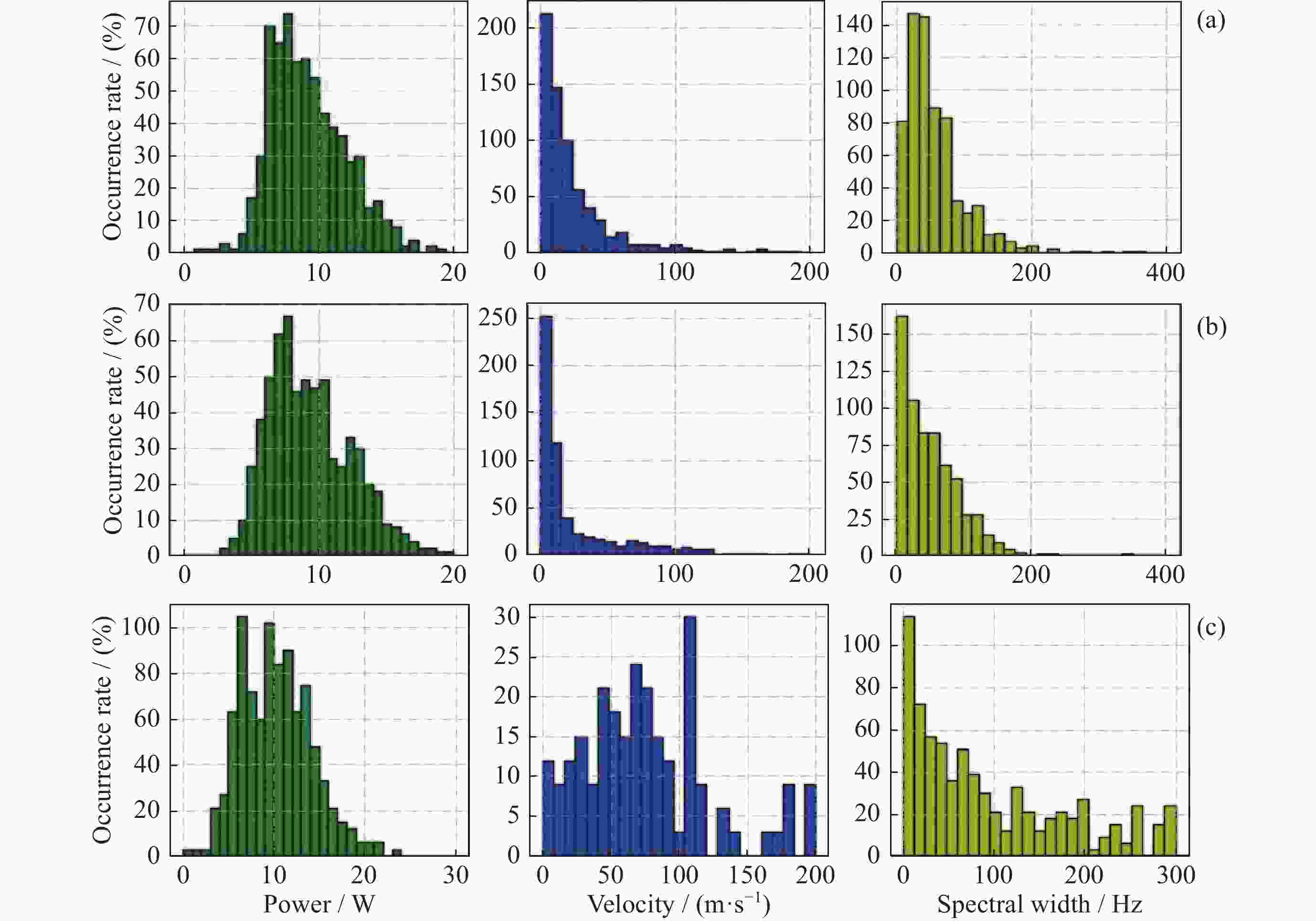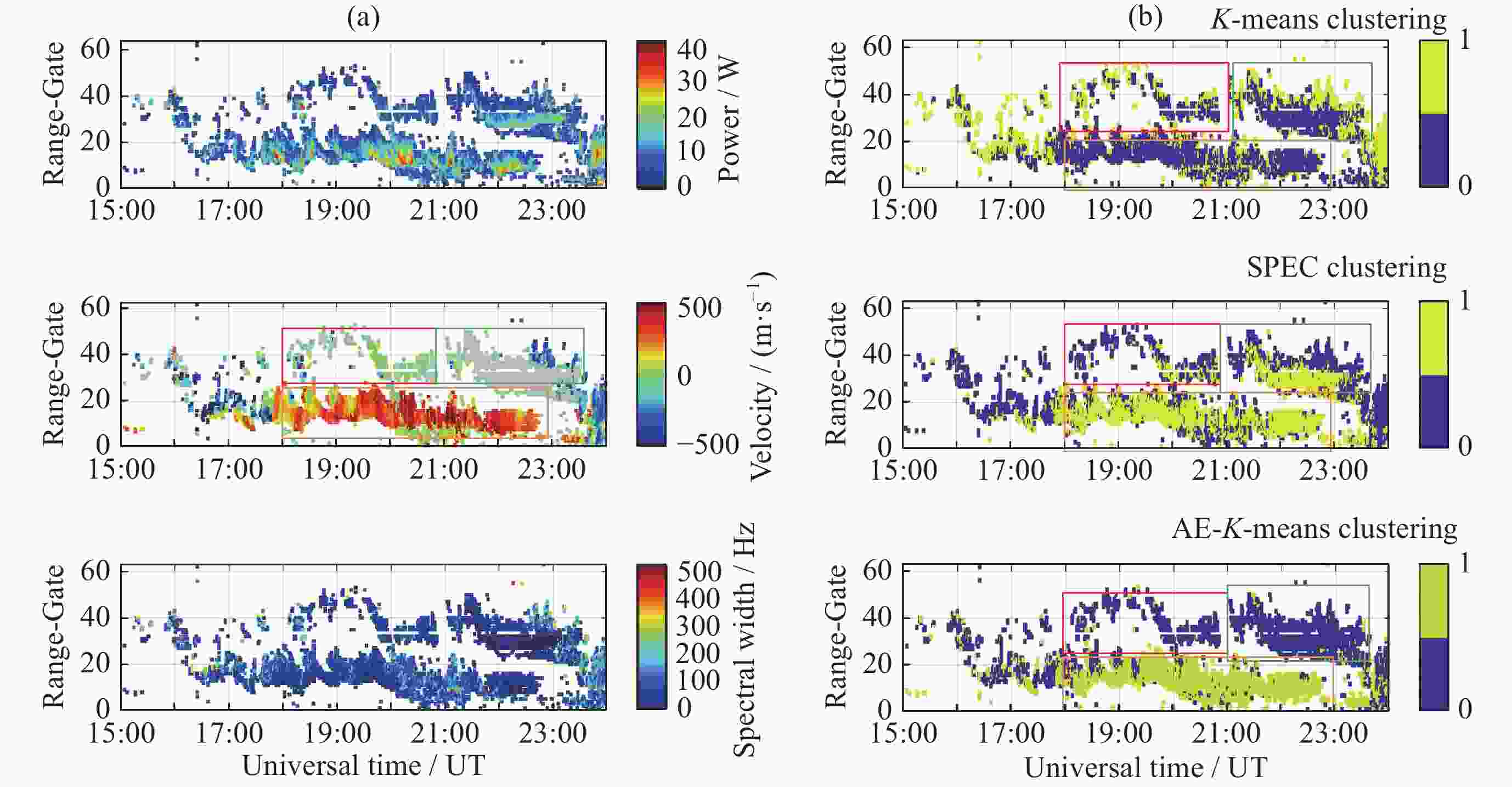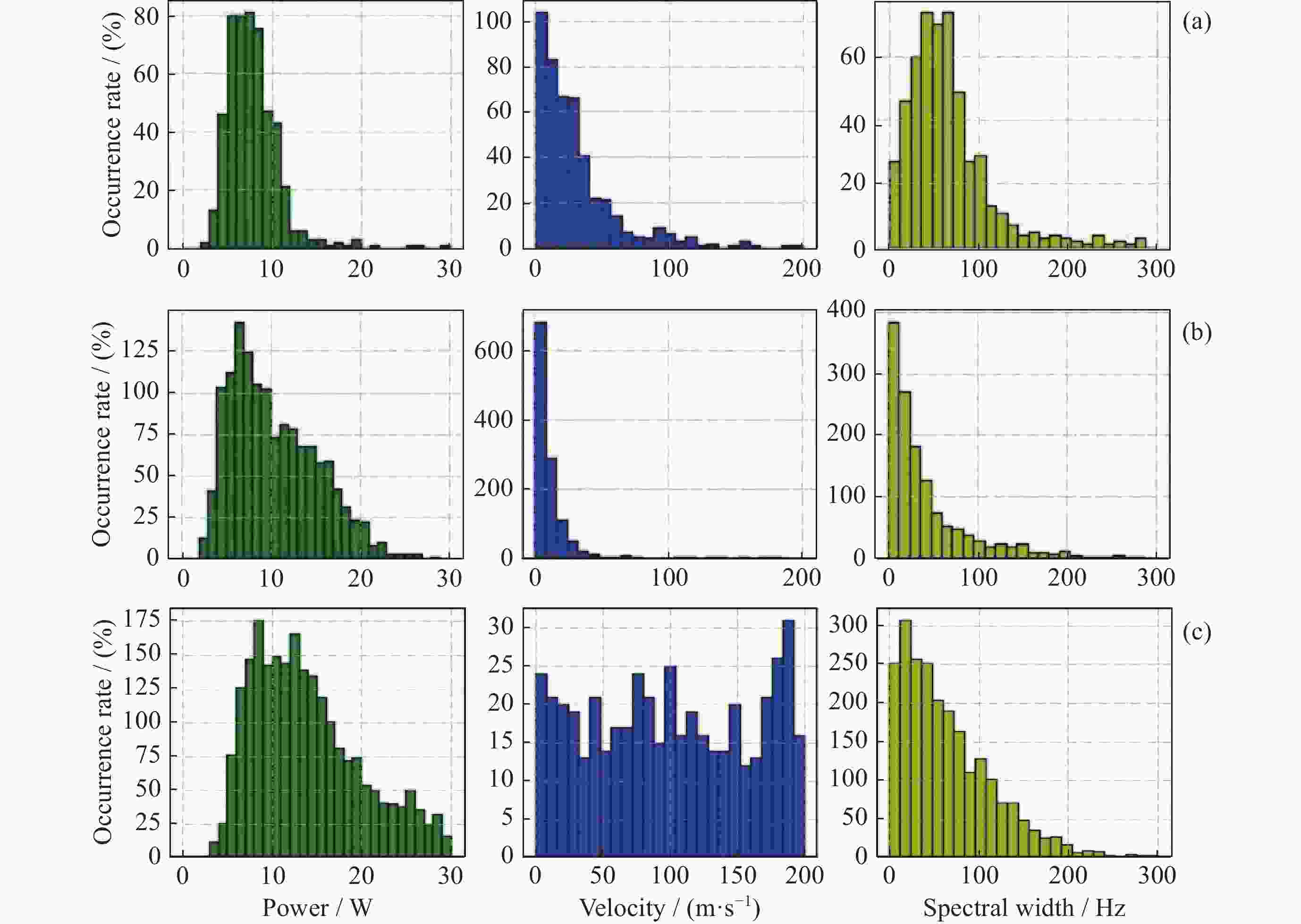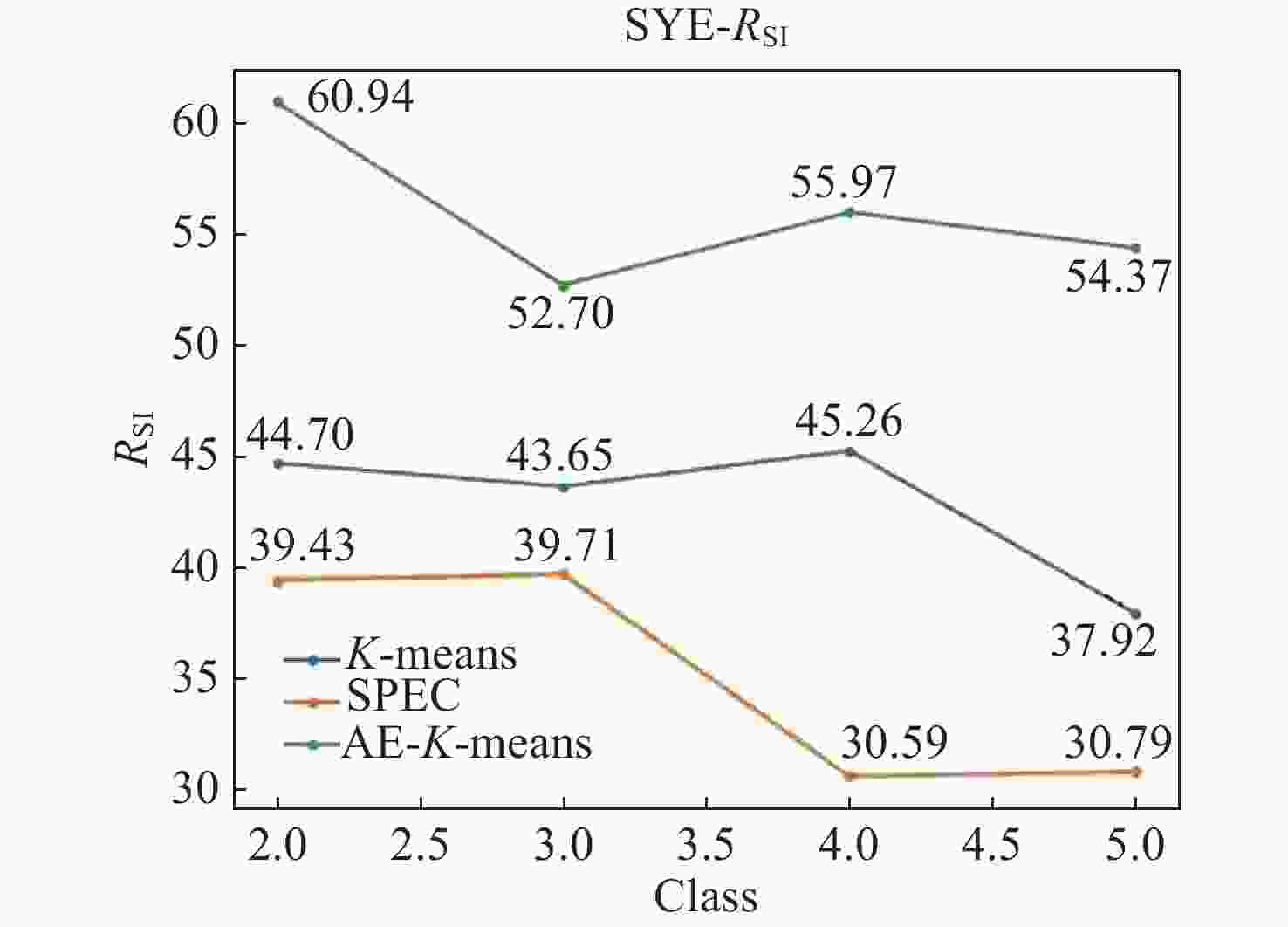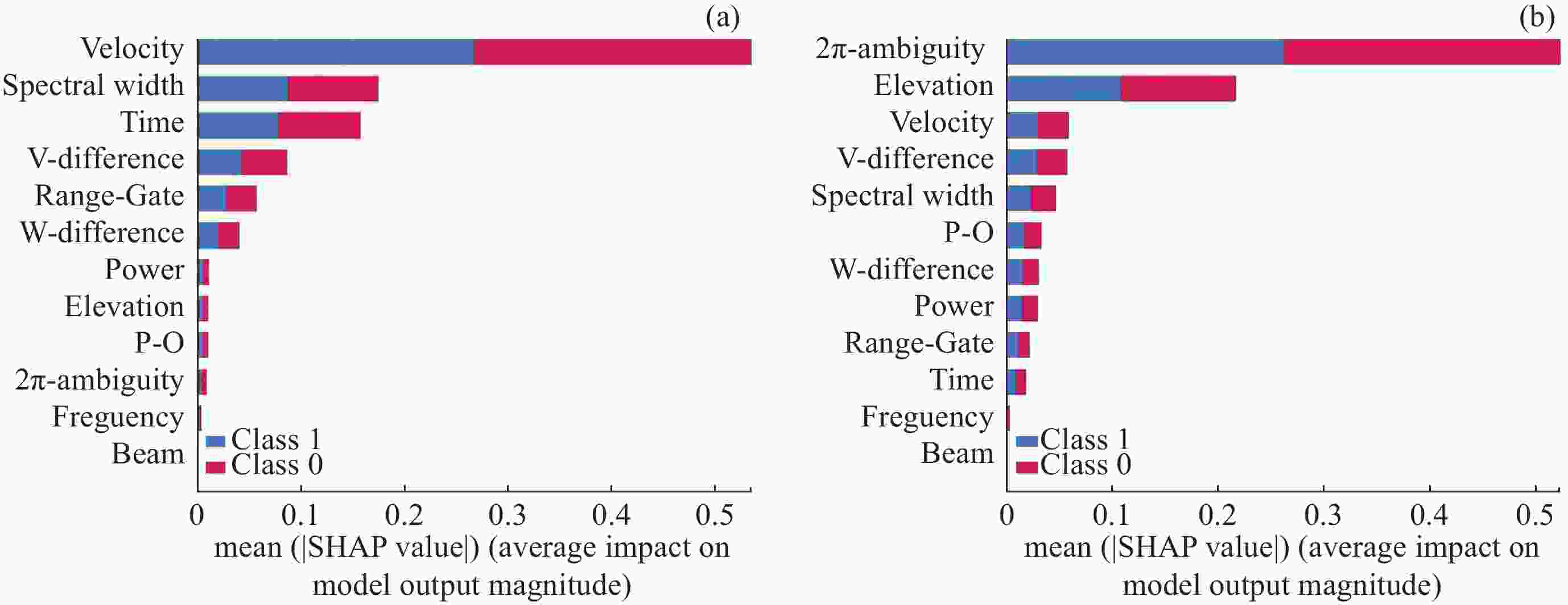深度聚类算法在SuperDARN雷达目标回波分类中的应用
doi: 10.11728/cjss2024.05.2023-0136 cstr: 32142.14.cjss2024.05.2023-0136
Application of Deep Clustering Algorithm in Target Echo Classification of SuperDARN Radar
-
摘要: SuperDARN雷达目标回波中通常包含多种类型散射的回波, 例如电离层不规则体回波、地面/海面散射回波、极区中层夏季回波以及流星余迹回波等. 利用SuperDARN采集的电离层回波制作的电离层对流图对于空间天气研究具有重要意义. SuperDARN接收到的电离层回波通常会与地面海面的散射回波混淆, 从而造成绘制的电离层对流图不准确, 因此对于SuperDARN目标回波进行聚类分析具有重要意义. 本文首次将基于自动编码器网络的图嵌入深度聚类算法应用于SuperDARN目标回波数据, 有效地对SuperDARN回波数据进行了分类. 此外, 还将该模型与传统算法和机器学习聚类算法进行了比较. 该模型在样本数据中的应用表明, 深度聚类算法能够捕捉到回波数据的深层结构特征, 提高了回波聚类的准确性.
-
关键词:
- SuperDARN雷达 /
- 深度聚类 /
- 自动编码器模型 /
- K-means聚类
Abstract: SuperDARN radar target echoes usually contain echoes of various types of scattering, such as ionospheric irregularities, ground/sea scatter echoes, polar mesosphere summer echoes and meteor trail echoes. The ionospheric echoes collected by SuperDARN radar are used to map the ionospheric convection to study the large-scale dynamics of the magnetosphere-ionospheric system, which is of great significance for space weather observation and exploration. In general, the scattered ionospheric echoes received by SuperDARN are often mixed with the scattered echoes from the ground or the sea, resulting in inaccurate ionospheric convection maps. Therefore, cluster analysis of SuperDARN target echoes is of great significance. Traditionally, ground/sea scattering is determined by the lower threshold of the combination of velocity and spectral width, but the scope of use of this method is limited, and there is ambiguity for the echoes in the mid-latitude region. In order to avoid the influence of latitude conditions and reduce the omission of useful information in the data, multiple data features of the radar target echo are collected as much as possible, such as line-of-sight Doppler velocity, the spectral width, backscatter power and the elevation angle of arrival. In this paper, the graph embedding deep clustering algorithm based on autoencoder network is applied to SuperDARN target echo data for the first time, and SuperDARN echo data is effectively classified. In addition, two different types of machine learning clustering algorithms are introduced to compare with this model. The deep clustering model, traditional classification algorithm and machine learning clustering algorithm are applied to the same echo data set, and the clustering results of different clustering algorithms are compared. The application of different clustering models on sample data sets and the evaluation of clustering indexes show that the deep clustering algorithm can capture the deep structural features of the echo data, effectively compress and reduce the dimensionality of the high-dimensional data set, make full use of the useful information in the data set, and improve the precision of the target echo data clustering of SuperDARN radar.-
Key words:
- SuperDARN radar /
- Deep clustering /
- Automatic encoder model /
- K-means clustering
-
表 1 数据集
Table 1. Data-Set
Radar Day Features SYE (Data-Set1) 2014-03-03 一天的时间(s), Range-Gate, 回波强度, 多普勒速度, 多普勒谱宽, 雷达自动处理 2π 模糊度
(使相位处于–π~π之间), 仰角, 速度误差, 谱宽误差, 初始功率p0 , 频率ZHO (Data-Set2) 2014-12-04 一天的时间(s), Range-Gate, 回波强度, 多普勒速度, 多普勒谱宽, 雷达自动处理 2π 模糊度
(使相位处于–π~π之间), 仰角, 速度误差, 谱宽误差, 初始功率p0 , 频率表 2 三种聚类算法得到的RSI值和RCH值
Table 2. RSI and RCH values obtained by three clustering algorithms
Score $ {R}_{\mathrm{S}\mathrm{I}} $ $ {R}_{\mathrm{C}\mathrm{H}} $ K-means 44.70 7449.96 SPEC 39.43 6376.27 AE-K-means 60.94 24421.17 表 3 不同算法设置不同K值聚类数据所得的RSI值
Table 3. Different algorithms set the RSI values obtained by clustering data with different K values
Class 2 3 4 5 K-means 44.70 43.65 45.26 37.92 SPEC 39.43 39.71 30.59 30.79 AE-K-means 60.94 52.70 55.97 54.37 表 4 AE-K-means算法的稳定性
Table 4. Stability of AE-K-means algorithm
频次 样本数量 1 3543, 6633 2 3798, 6378 3 3774, 6402 4 3531, 6645 5 3951, 6225 -
[1] KUSTOV A V, PAPITASHVILI V O, SOFKO G J, et al. Dayside ionospheric plasma convection, electric fields, and field‐aligned currents derived from the SuperDARN radar observations and predicted by the IZMEM model[J]. Journal of Geophysical Research: Space Physics, 1997, 102(A11): 24057-24067 doi: 10.1029/97JA02309 [2] MARCUCCI M F, COCO I, MASSETTI S, et al. Echo occurrence in the southern polar ionosphere for the SuperDARN Dome C East and Dome C North radars[J]. Polar Science, 2021, 28: 100684 doi: 10.1016/j.polar.2021.100684 [3] GREENWALD R A. History of the Super Dual Auroral Radar Network (SuperDARN)-I: pre-SuperDARN developments in high frequency radar technology for ionospheric research and selected scientific results[J]. History of Geo- and Space Sciences, 2021, 12(1): 77-93 doi: 10.5194/hgss-12-77-2021 [4] CHISHAM G, PINNOCK M. Assessing the contamination of SuperDARN global convection maps by non-F-region backscatter[J]. Annales Geophysicae, 2002, 20(1): 13-28 doi: 10.5194/angeo-20-13-2002 [5] ULLAH S, LI H L, RAUF A, et al. Effect of ions on conductivity and permittivity in the Polar Mesosphere Summer Echoes region[J]. Earth and Planetary Physics, 2021, 5(2): 196-204 doi: 10.26464/epp2021016 [6] VILLAIN J P, GREENWALD R A, BAKER K B, et al. HF radar observations of E region plasma irregularities produced by oblique electron streaming[J]. Journal of Geophysical Research: Space Physics, 1987, 92(A11): 12327-12342 doi: 10.1029/JA092iA11p12327 [7] BARTHES L, ANDRÉ R, CERISIER J C, et al. Separation of multiple echoes using a high-resolution spectral analysis for SuperDARN HF radars[J]. Radio Science, 1998, 33(4): 1005-1017 doi: 10.1029/98RS00714 [8] SCHMIDT R. Multiple emitter location and signal parameter estimation[J]. IEEE Transactions on Antennas and Propagation, 1986, 34(3): 276-280 doi: 10.1109/TAP.1986.1143830 [9] GREENWALD R A, BAKER K B, DUDENEY J R, et al. Darn/superdarn: a global view of the dynamics of high-latitude convection[J]. Space Science Reviews, 1995, 71(71): 761-796 [10] PONOMARENKO P V, WATERS C L, MENK F W. Factors determining spectral width of HF echoes from high latitudes[J]. Annales Geophysicae, 2007, 25(3): 675-687 doi: 10.5194/angeo-25-675-2007 [11] PONOMARENKO P V, WATERS C L, MENK F W. Effects of mixed scatter on SuperDARN convection maps[J]. Annales Geophysicae, 2008, 26(6): 1517-1523 doi: 10.5194/angeo-26-1517-2008 [12] BLANCHARD G T, SUNDEEN S, BAKER K B. Probabilistic identification of high-frequency radar backscatter from the ground and ionosphere based on spectral characteristics[J]. Radio Science, 2009, 44(5): RSSO12 [13] RIBEIRO A J, RUOHONIEMI J M, BAKER J B H, et al. A new approach for identifying ionospheric backscatter in midlatitude SuperDARN HF radar observations[J]. Radio Science, 2011, 46(4): RS4011 [14] BURRELL A G, MILAN S E, PERRY G W, et al. Automatically determining the origin direction and propagation mode of high-frequency radar backscatter[J]. Radio Science, 2015, 50(12): 1225-1245 doi: 10.1002/2015RS005808 [15] CHANG J F, LU Y, XUE P, et al. Iterative clustering pruning for convolutional neural networks[J]. Knowledge-Based Systems, 2023, 265: 110386 doi: 10.1016/j.knosys.2023.110386 [16] CHUI K T. Driver stress recognition for smart transportation: applying multiobjective genetic algorithm for improving fuzzy c-means clustering with reduced time and model complexity[J]. Sustainable Computing: Informatics and Systems, 2022, 35: 100668 doi: 10.1016/j.suscom.2022.100668 [17] DUTTA R, DAS N, MAJUMDER M, et al. Aspect based sentiment analysis using multi‐criteria decision‐making and deep learning under COVID‐19 pandemic in India[J]. CAAI Transactions on Intelligence Technology, 2023, 8(1): 219-234 doi: 10.1049/cit2.12144 [18] WAGNER F H, DALAGNOL R, SÁNCHEZ A H, et al. K-textures, a self-supervised hard clustering deep learning algorithm for satellite image segmentation[J]. Frontiers in Environmental Science, 2022, 10: 946729 doi: 10.3389/fenvs.2022.946729 [19] ANITHA T, LATHA G P L, PRASAD M S. A proficient adaptive K-means based brain tumor segmentation and detection using deep learning scheme with PSO[J]. Journal of Computational Science & Intelligent Technologies, 2020, 1(3): 9-14 [20] 刘二小, 胡红桥, 刘瑞源, 等. 中山站高频雷达回波的日变化特征及地磁活动的影响[J]. 地球物理学报, 2012, 55(9): 3066-3076 doi: 10.6038/j.issn.0001-5733.2012.09.024LIU E X, HU H Q, LIU R Y, et al. Diurnal variation of the HF radar echoes at Zhongshan Station and the influence of geomagnetic activity[J]. Chinese Journal of Geophysics, 2012, 55(9): 3066-3076 doi: 10.6038/j.issn.0001-5733.2012.09.024 [21] RIBEIRO A J, RUOHONIEMI J M, PONOMARENKO P V, et al. A comparison of SuperDARN ACF fitting methods[J]. Radio Science, 2013, 48(3): 274-282 doi: 10.1002/rds.20031 [22] KIM Y, HEILAND J. Convolutional autoencoders, clustering and POD for low-dimensional parametrization of navier-stokes equations[OL]. arXiv preprint arXiv: 2302.01278, 2023 [23] HINTON G E, ZEMEL R S. Autoencoders, minimum description length and Helmholtz free energy[C]//Proceedings of the 6th International Conference on Neural Information Processing Systems. Denver: Morgan Kaufmann Publishers Inc. , 1993 [24] HU H Q, LIU E X, LIU R Y, et al. Statistical characteristics of ionospheric backscatter observed by SuperDARN Zhongshan radar in Antarctica[J]. Advances in Polar Science, 2013, 24(1): 19-31 -
-





 孔星 女, 1998年出生于山东省济宁市, 现为杭州电子科技大学研究生, 主要研究方向是SuperDARN雷达目标回波数据处理. E-mail:
孔星 女, 1998年出生于山东省济宁市, 现为杭州电子科技大学研究生, 主要研究方向是SuperDARN雷达目标回波数据处理. E-mail: 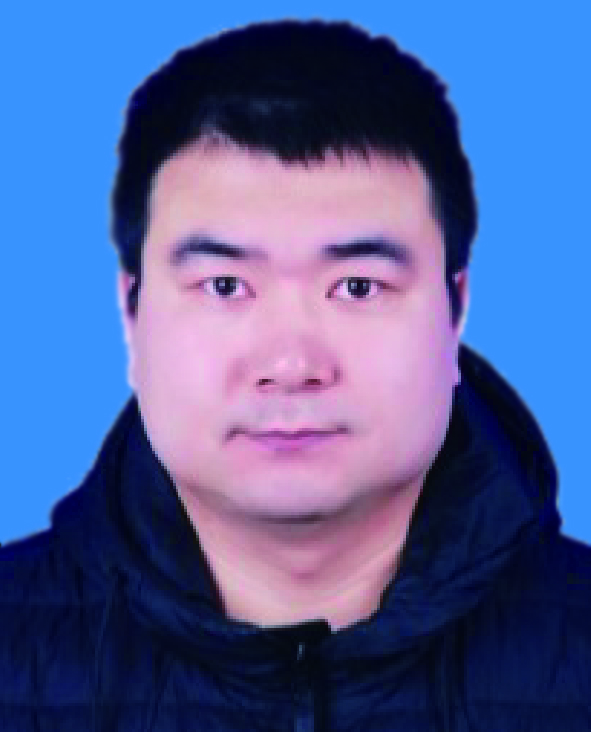
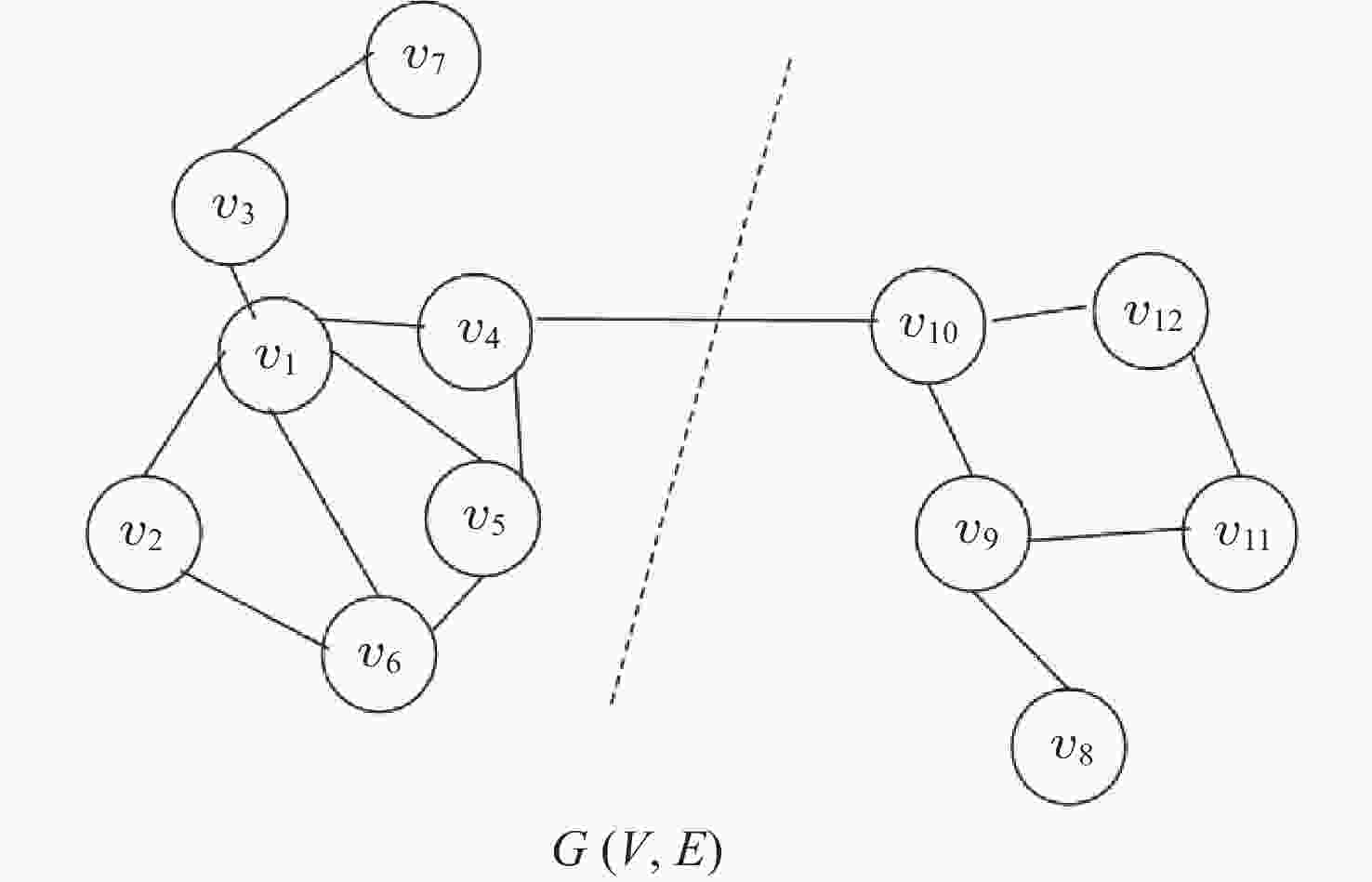
 下载:
下载:
